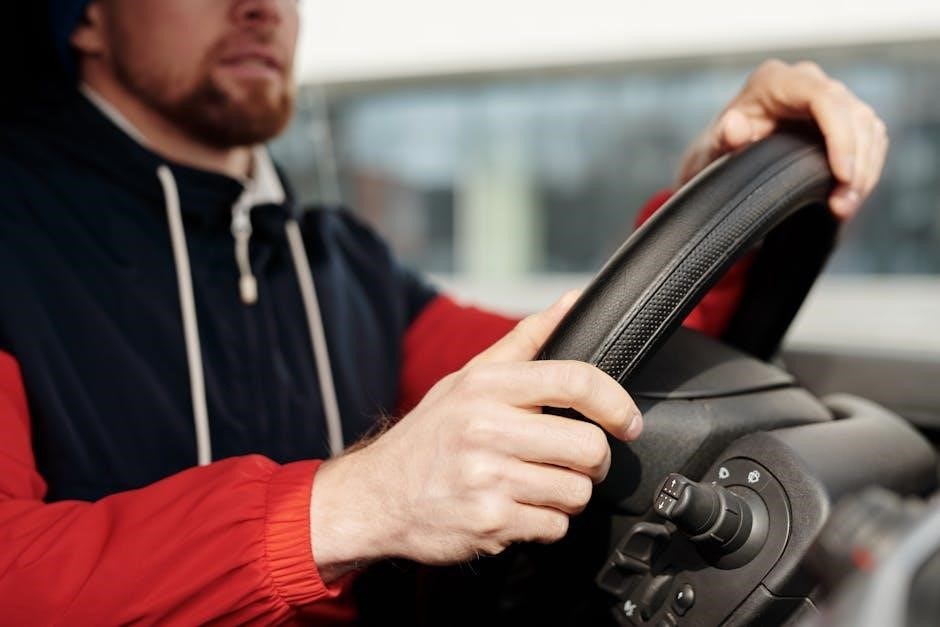Auto start technology enhances convenience and efficiency in manual cars, integrating seamlessly with clutch and brake systems․ It offers remote start functionality, safety features, and reduced emissions, making it a modern solution for drivers seeking ease without compromising control․

By adapting traditional manual transmissions to modern auto start systems, drivers enjoy a blend of innovation and familiarity, ensuring a smooth and secure driving experience․
Overview of Auto Start Technology
Auto start technology allows vehicles to start automatically, enhancing convenience and efficiency․ For manual cars, it integrates with sensors and electronics to ensure smooth operation․ The system adapts to manual transmissions, incorporating safety features like emergency stop and anti-theft protection․ Remote start functionality is enabled, with compatibility ensured through advanced components․ This technology learns driver habits, optimizing performance while maintaining control․ It seamlessly blends innovation with traditional driving, offering a secure and user-friendly experience․
Importance of Auto Start in Modern Vehicles
Auto start technology is crucial in modern vehicles, offering enhanced convenience, fuel efficiency, and safety․ It reduces emissions, minimizes wear on transmissions, and provides seamless remote starting․ For manual cars, it ensures a smooth driving experience, adapting to driver habits․ This feature is especially beneficial in urban settings, where frequent stops are common․ By integrating advanced sensors and fail-safe mechanisms, auto start systems enhance overall vehicle performance and user satisfaction, making them a valuable addition to contemporary automotive innovations․

What is Auto Start for Manual Cars?
Auto start for manual cars is a technology enabling automatic engine ignition without manual key turning, integrating with clutch and brake systems for seamless remote starts․
Definition and Functionality
Auto start for manual cars is a system enabling automatic engine ignition via remote control or button, eliminating the need for manual key turning or clutch pressing․ It integrates sensors to detect neutral gear or clutch position, ensuring safe starts․ This technology simplifies remote starting, enhances convenience, and reduces starter motor wear․ It’s designed for compatibility with manual transmissions, offering a modern solution for drivers who prefer manual control but desire added ease and comfort in their driving experience․
Key Components of Auto Start Systems
Auto start systems for manual cars rely on several critical components․ Sensors detect the vehicle’s status, such as neutral gear or clutch position, ensuring safe ignition․ An electronic control unit (ECU) processes signals and activates the starter motor․ A remote transmitter sends commands to the system, while a bypass module integrates with the vehicle’s wiring․ Additional components include safety features like fail-safe mechanisms and anti-theft protection․ These elements work together to enable seamless, secure, and efficient remote starting, tailored for manual transmissions․
How Auto Start Differs from Traditional Start Systems
Auto start systems differ by incorporating advanced sensors and electronics to enable remote ignition and seamless operation․ Unlike traditional systems, auto start integrates with clutch and brake pedals, ensuring safe starting without manual input․ It also features fail-safe mechanisms to prevent accidental starts in gear․ Remote functionality adds convenience, while traditional systems rely solely on physical ignition․ These advancements make auto start more versatile and user-friendly, especially for manual cars, where safety and control are prioritized․

Benefits of Auto Start for Manual Cars
Auto start offers convenience, improved fuel efficiency, and enhanced safety for manual cars while reducing transmission wear․ These benefits make it a valuable upgrade․
Convenience and Ease of Use
Auto start systems for manual cars eliminate the need for manual key turning or clutch pressing, offering a seamless starting experience․ This technology integrates smoothly with the clutch and brake pedals, ensuring an intuitive user experience․ Drivers can start the engine effortlessly, even in heavy traffic or frequent stop-and-go situations, without compromising control․ Remote start functionality further enhances convenience, allowing drivers to start the car from a distance․ This feature not only saves time but also reduces the physical effort required to operate the vehicle, making it ideal for modern drivers seeking ease and efficiency․
Fuel Efficiency and Reduced Emissions
Auto start systems in manual cars significantly improve fuel efficiency by preventing unnecessary idling during stops․ This technology automatically shuts off the engine at red lights or in traffic, reducing fuel consumption and lowering emissions․ By minimizing idle time, drivers save money on fuel costs while contributing to environmental sustainability․ The system seamlessly restarts the engine when the driver is ready to accelerate, ensuring a smooth transition․ This feature is particularly beneficial in urban driving conditions, where frequent stops are common, making it a practical choice for eco-conscious drivers․
Enhanced Safety Features
Auto start systems for manual cars incorporate advanced safety features to protect both the vehicle and its occupants․ These systems often include fail-safe mechanisms that prevent accidental starts without proper clutch and brake engagement․ Additionally, they may feature anti-theft protection, ensuring the car cannot be started or moved without authorization․ Some models include emergency stop functionalities, providing an extra layer of security․ These features work seamlessly with traditional safety systems, offering peace of mind for drivers․ Enhanced safety measures make auto start technology a reliable choice for modern vehicles․
Reduced Wear and Tear on the Transmission
Auto start systems for manual cars help minimize wear and tear on the transmission by preventing abrupt starts and ensuring smooth gear engagement․ By automating the starting process, these systems reduce the risk of clutch and gear grinding, common issues in manual vehicles․ This results in a longer lifespan for the transmission and related components․ Additionally, the controlled startup process minimizes mechanical stress, further protecting the gearbox․ Regular use of auto start technology can lead to cost savings over time by reducing the need for transmission repairs and maintenance․

How Auto Start Works in Manual Cars
Auto start systems in manual cars use sensors to detect when the clutch is in neutral, enabling electronic signals to activate the starter motor smoothly․
Role of Sensors and Electronics
Sensors detect the position of the clutch and gearshift, ensuring the car is in neutral before starting․ Electronic control units process signals to activate the starter motor seamlessly․
Clutch and Brake Pedal Integration

The auto start system integrates with the clutch and brake pedals to ensure safe and seamless operation․ Sensors monitor the clutch pedal’s position, ensuring the car is in neutral before starting․ The brake pedal must be pressed to activate the start or shift gears, preventing accidental movement․ This integration maintains manual control while adding convenience, making it easier to handle stops and starts in traffic without constant pedal operation, enhancing the driving experience for manual car owners․
Remote Start Functionality
Remote start functionality allows manual car owners to start their engine from a distance, offering unparalleled convenience․ The system ensures safety by requiring the car to be in neutral gear, detected by sensors, before ignition․ Users can activate the feature using a key fob or smartphone app, with some systems requiring a brake pedal press for added security․ This feature is particularly useful in extreme weather conditions, enabling drivers to cool or heat their vehicle before entry․ Advanced systems like Compustar are designed to work safely with manual transmissions, preventing accidental starts or theft․
Safety Features of Auto Start Systems
Auto start systems include emergency stop and anti-theft protection, ensuring secure operation․ Fail-safe mechanisms prevent accidental starts, while advanced encryption protects against unauthorized access, safeguarding your vehicle․
Emergency Stop and Anti-Theft Protection
Auto start systems for manual cars feature an emergency stop mechanism that halts the engine immediately if unauthorized access is detected․ This ensures the vehicle remains secure, even in remote start mode․ Advanced anti-theft protection incorporates encryption and passive immobilization, preventing thieves from hotwiring or bypassing the system․
These safety measures are designed to protect both the driver and the vehicle․ In case of a breach, the system automatically engages failsafe protocols, ensuring the car cannot be moved without proper authorization․
Fail-Safe Mechanisms
Auto start systems for manual cars are equipped with fail-safe mechanisms to prevent accidental starts or unauthorized use․ These mechanisms automatically disengage the starter if the clutch is not pressed or if the vehicle detects an abnormal condition․ Sensors continuously monitor the car’s state, ensuring the engine only starts under safe conditions․
If the system detects potential theft or tampering, it disables the engine and triggers alarms․ This ensures the vehicle remains secure and prevents unintended operation, adding an extra layer of safety and reliability to the auto start feature․
Installation Considerations
Installation Considerations for auto start systems require compatibility checks with manual transmissions․ Professional installation is recommended to ensure safety and functionality․ Trusted brands like Compustar offer reliable solutions․
Compatibility with Manual Transmissions
Auto start systems for manual cars require specific compatibility checks․ Modern solutions, like Compustar, are designed to work safely with manual transmissions, ensuring smooth integration․ These systems often include safety mechanisms to prevent accidental starts while in gear․ Compatibility ensures the car remains stationary during remote starts, enhancing security․ Professional installation is crucial to maintain functionality and safety․ Proper integration prevents potential risks associated with older methods․ Modern auto start systems are now viable options for manual cars, offering convenience without compromising safety or performance․
Professional Installation Requirements
Professional installation is crucial for auto start systems in manual cars․ While some may consider DIY installation, it’s not recommended due to the complexity of integrating modern auto start technology with manual transmissions․ Professional installers have the specialized knowledge and tools to ensure correct and safe functionality, adhering to manufacturer guidelines․ They configure safety mechanisms to prevent accidental starts and ensure all components work seamlessly․ Improper installation can lead to malfunctions, safety risks, or damage to electrical and transmission systems․ Expert assistance is highly advisable for a reliable and secure setup․

Maintenance and Troubleshooting
Regular checks of sensors, wiring, and software updates ensure smooth auto start operation․ Addressing issues like faulty solenoids or misaligned pedals promptly prevents system failures and enhances reliability․
Regular Maintenance Tips
Regular maintenance ensures optimal performance of auto start systems in manual cars․ Check battery health, wiring connections, and software updates periodically․ Ensure proper tyre pressure and tread depth․ Inspect clutch and brake pedals for smooth operation․ Address any sensor malfunctions promptly․ Keep the system clean and free from debris․ Follow manufacturer guidelines for servicing to prevent unexpected issues․ Routine checks help maintain fuel efficiency and reduce emissions, ensuring a reliable driving experience․
Common Issues and Solutions
Common issues with auto start systems in manual cars include faulty sensors, wiring problems, and clutch position errors․ Solutions involve checking sensor accuracy, inspecting wiring connections, and ensuring proper clutch alignment․ Addressing these issues promptly prevents system malfunctions․ Regularly updating software and ensuring battery health also resolves many problems․ If issues persist, consulting a professional technician is recommended to avoid further complications․ Timely fixes ensure smooth operation and maintain the integrity of the auto start system․
Auto start technology revolutionizes manual cars by blending convenience, safety, and efficiency, offering drivers a modern solution without sacrificing control, while paving the way for future innovations․
Future of Auto Start Technology
As technology advances, auto start systems for manual cars will likely integrate more seamlessly with AI and smartphone apps, enhancing convenience and safety․ Future developments may include advanced sensors for better efficiency and reduced emissions․ Compatibility with manual transmissions will improve, making remote start systems more accessible․ Additionally, these systems could incorporate predictive maintenance features, ensuring optimal performance․ The integration of auto start with eco-friendly technologies will further solidify its role in sustainable mobility solutions․
